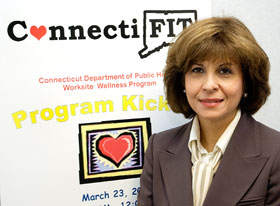  |
| HOME | THIS ISSUE | CALENDAR | GRANTS | BACK ISSUES | < BACK | NEXT > |
Voluntary health promotion program brings exercise to the workplaceby Sherry Fisher & Beth Krane - February 6, 2006 |
||||
|
Last summer, Liliana McIntyre spent her lunch hour and breaks walking in Hartford. At the end of 10 weeks, she and 121 others had walked a total of enough miles combined to get a person to the Grand Canyon — and back — twice. McIntyre and her fellow employees took part in a ConnectiFIT walking program. ConnectiFIT is a voluntary health promotion program created to improve the health and productivity of employees of Connecticut state agencies. The Department of Public Health is the first agency to offer the program. The principal investigator is Dr. Pouran Faghri, an associate professor of allied health, in collaboration with the public health department. The program is supported by the Centers for Disease Control and Prevention’s Cardiovascular Health Program. “We want people to become aware of healthy behaviors and motivate them to adopt these behaviors,” says Faghri. “The idea behind the 10-week walking program was to increase the level of physical activity during working hours. We wanted to see if we could increase the number of steps that people took while at work.” She adds, “Initiating a change in behavior of a population requires knowledge of the risk factors affecting the population, as well as an organized approach to targeting these risks. Through the ConnectiFIT project, we collect data on the risk factors affecting the employees’ health and try to change those by implementing appropriate interventions.” The walk to the Grand Canyon was one of a number of programs offered through ConnectiFIT that allow employees to incorporate health and wellness into their work hours. A second walking program, National Parks Exploration, also drew a good crowd. During that 10-week program, 100 employees “walked” to 14 national parks located throughout the country. Those who participated in the walk to the Grand Canyon – a 2,530 mile excursion from Hartford – as well as the National Park exploration, wore pedometers to track the number of steps they took each day. They walked designated city routes in teams of five or six during their lunch hours and breaks, also recording any other steps taken at work, such as walking from their cars to their offices. Logs were kept of the number of steps taken, and maps indicated how far they were from their destination. “It was an awesome experience,” says McIntyre, an administrative assistant with Public Health Initiatives. “It put the focus back on my health, and helped me make time for me. I’m very family focused, and always push my needs aside. Having this program at work was fantastic. The more I walked, the less I wanted the candy bar.” McIntyre, who lost 20 pounds during the program, says that when it ended, she started walking on the weekends. Justin Peng, an epidemiologist, was a team leader in the National Parks walk. “It gets you out, and you come back more energetic,” says Peng, who had previously worked through his lunch breaks. “I don’t get to exercise much outside of here.” Vivian Henry also participated in the National Parks walk.
“It made me more aware that I could exercise without paying hundreds of dollars to a gym,” says Henry, an administrative assistant with Health Information Systems. “It was motivating. You try to walk more each day.” Four other state agencies are expected to try ConnectiFIT in the near future. “The idea of ConnectiFIT is to get the state of Connecticut in better shape,” says Faghri. “Sixty-five percent of people work, and those who do, spend about two-thirds of their time at the job and consume most of their calories there. People need exercise, but by the time a person gets home, they don’t have time to exercise. So we have a population who are dying of chronic conditions such as cardiovascular disease and diabetes, which are largely modifiable through behavioral change.” Faghri adds, “The program also provides an environment for students to have hands-on experience on how to design, implement, and evaluate health promotion programs.” Four graduate students currently work on the project. According to Faghri, in a self-reported study of Connecticut residents, 55 percent of adults surveyed were either overweight or obese. Forty-eight percent reported that they did not participate in any kind of moderate physical activity. “Physical inactivity puts our state residents at risk for many chronic conditions,” Faghri says. “That’s why ConnectiFIT is important.” Studies have also shown that wellness programs at worksites boost morale, decrease absenteeism, and increase overall productivity, she says. In addition to the organized walking programs, ConnectiFIT uses tools such as a website, newsletter, seminars, posters, and screen savers to promote awareness of healthy behavior. The state health department also supports the health promotion program by providing healthier alternatives in the cafeteria and vending machines. Dr. J. Robert Galvin, commissioner of the state department of public health, says ConnectiFIT is very popular with the department’s employees. “We are proud of its success,” Galvin says. “Providing an environment where employees can learn about and implement healthy lifestyle changes makes good sense. We hope to expand ConnectiFIT to other agencies and employers as part of our efforts to achieve a healthier, happier, and more productive Connecticut workforce.” For more information about ConnectiFIT, visit the website at http://connectifit.uconn.edu. |
| ADVANCE HOME UCONN HOME |

